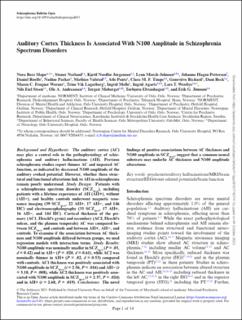Auditory Cortex Thickness Is Associated With N100 Amplitude in Schizophrenia Spectrum Disorders
| dc.contributor.author | Slapø, Nora Berz | |
| dc.contributor.author | Nerland, Stener | |
| dc.contributor.author | Jørgensen, Kjetil Nordbø | |
| dc.contributor.author | Mørch-Johnsen, Lynn Egeland | |
| dc.contributor.author | Pettersen, Johanne Hagen | |
| dc.contributor.author | Roelfs, Daniel | |
| dc.contributor.author | Parker, Nadine | |
| dc.contributor.author | Valstad, Mathias | |
| dc.contributor.author | Pentz, Atle Bråthen | |
| dc.contributor.author | Timpe, Clara Marie Fides | |
| dc.contributor.author | Richard, Genevieve | |
| dc.contributor.author | Beck, Dani | |
| dc.contributor.author | Werner, Maren Caroline Frogner | |
| dc.contributor.author | Lagerberg, Trine Vik | |
| dc.contributor.author | Melle, Ingrid | |
| dc.contributor.author | Agartz, Ingrid | |
| dc.contributor.author | Westlye, Lars Tjelta | |
| dc.contributor.author | Steen, Nils Eiel | |
| dc.contributor.author | Andreassen, Ole | |
| dc.contributor.author | Moberget, Torgeir | |
| dc.contributor.author | Elvsåshagen, Torbjørn | |
| dc.contributor.author | Jönsson, Erik G. | |
| dc.contributor.author | Jönsson, Erik Gunnar | |
| dc.date.accessioned | 2023-10-05T05:51:26Z | |
| dc.date.available | 2023-10-05T05:51:26Z | |
| dc.date.created | 2023-06-13T19:44:01Z | |
| dc.date.issued | 2023 | |
| dc.identifier.issn | 0586-7614 | |
| dc.identifier.uri | https://hdl.handle.net/11250/3094309 | |
| dc.description.abstract | Background and Hypothesis: The auditory cortex (AC) may play a central role in the pathophysiology of schizophrenia and auditory hallucinations (AH). Previous schizophrenia studies report thinner AC and impaired AC function, as indicated by decreased N100 amplitude of the auditory evoked potential. However, whether these structural and functional alterations link to AH in schizophrenia remain poorly understood. Study Design: Patients with a schizophrenia spectrum disorder (SCZspect), including patients with a lifetime experience of AH (AH+), without (AH−), and healthy controls underwent magnetic resonance imaging (39 SCZ spect, 22 AH+, 17 AH−, and 146 HC) and electroencephalography (33 SCZ spect, 17 AH+, 16 AH−, and 144 HC). Cortical thickness of the primary (AC1, Heschl’s gyrus) and secondary (AC2, Heschl’s sulcus, and the planum temporale) AC was compared between SCZ spect and controls and between AH+, AH−, and controls. To examine if the association between AC thickness and N100 amplitude differed between groups, we used regression models with interaction terms. Study Results: N100 amplitude was nominally smaller in SCZ spect (P = .03, d = 0.42) and in AH− (P = .020, d = 0.61), while AC2 was nominally thinner in AH+ (P = .02, d = 0.53) compared with controls. AC1 thickness was positively associated with N100 amplitude in SCZspect (t = 2.56, P = .016) and AH− (t= 3.18, P = .008), while AC2 thickness was positively associated with N100 amplitude in SCZspect (t = 2.37, P = .024) and in AH+ (t = 2.68, P = .019). Conclusions: The novel indings of positive associations between AC thickness and N100 amplitude in SCZ spect, suggest that a common neural substrate may underlie AC thickness and N100 amplitude alterations. | en_US |
| dc.language.iso | eng | en_US |
| dc.rights | Navngivelse-Ikkekommersiell 4.0 Internasjonal | * |
| dc.rights.uri | http://creativecommons.org/licenses/by-nc/4.0/deed.no | * |
| dc.title | Auditory Cortex Thickness Is Associated With N100 Amplitude in Schizophrenia Spectrum Disorders | en_US |
| dc.type | Peer reviewed | en_US |
| dc.type | Journal article | en_US |
| dc.description.version | publishedVersion | en_US |
| cristin.ispublished | true | |
| cristin.fulltext | original | |
| cristin.qualitycode | 2 | |
| dc.identifier.doi | 10.1093/schizbullopen/sgad015 | |
| dc.identifier.cristin | 2154280 | |
| dc.source.journal | Schizophrenia Bulletin | en_US |
| dc.source.volume | 4 | en_US |
| dc.source.issue | 1 | en_US |
Tilhørende fil(er)
Denne innførselen finnes i følgende samling(er)
-
HV - Institutt for atferdsvitenskap [249]
HV - Department of Behavioural Sciences -
Publikasjoner fra Cristin [3201]

